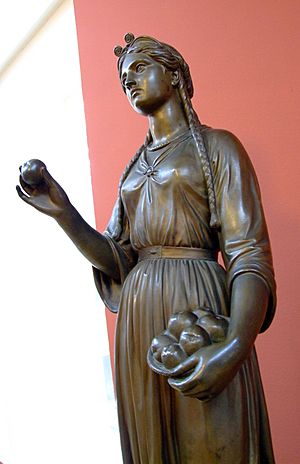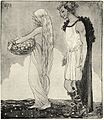Iðunn facts for kids
In Norse mythology, Iðunn is a special goddess. She is known for her magical apples that keep the gods young forever! Iðunn is mentioned in old Norse stories like the Poetic Edda and the Prose Edda. These books were written a long time ago, in the 13th century. In these stories, Iðunn is the wife of Bragi, who is the god of poetry. She is also the keeper of the amazing apples that grant eternal youthfulness.
Contents
The Story of Iðunn and Her Apples
One day, the trickster god Loki was forced by a giant named Þjazi to trick Iðunn. Þjazi made Loki promise to bring Iðunn out of Asgard, the home of the gods. Loki told Iðunn that he had found even more beautiful apples in a nearby wood. He convinced her to come with him to see them.
Iðunn's Abduction
When Iðunn was in the wood, Þjazi suddenly appeared! He had changed into the shape of a giant eagle. The eagle grabbed Iðunn and flew far away to his own home.
The Gods Grow Old
Without Iðunn and her special apples, the gods in Asgard started to grow old and weak. Their hair turned grey, and they lost their strength. They soon realized that Iðunn was missing and that Loki was responsible. The gods were very angry with Loki!
Loki's Rescue Mission
To make things right, Loki promised to bring Iðunn back. He changed into a falcon and flew off to find her. He finally found Iðunn alone at Þjazi's home. Loki quickly turned Iðunn into a nut so he could carry her easily. Then, he flew back towards Asgard as fast as he could.
The Chase and Þjazi's End
When Þjazi returned and saw Iðunn was gone, he changed back into his eagle form. He flew after Loki, chasing him across the sky. The gods in Asgard saw Loki flying towards them with the giant eagle close behind. They quickly built a huge fire, called a pyre, in the courtyard.
Just as Loki reached the edge of the fire, he stopped. But Þjazi, flying too fast, couldn't stop! He plunged straight through the flames. His feathers caught fire, and he fell to the ground. The gods then attacked and killed the giant Þjazi. Iðunn was safe, and the gods could eat her apples again and become young once more!
What Iðunn's Name Means
The name Iðunn has a special meaning. It can mean "ever young," "rejuvenator," or "the one who makes things young again." Because the modern English alphabet doesn't have the letter 'ð' (called an eth), her name is sometimes spelled as Idhunn, Idunn, Idun, or Ithun. Sometimes, an '-a' is added to the end to show it's a girl's name, like Iduna or Idunna.
Iðunn in Art and Modern Culture
Iðunn has been a popular subject for artists for a long time. Many statues and paintings show her, often with her basket of apples. For example, there are artworks like "Idun" (1821) by H. E. Freund and "Idun and the Apples" (1890) by J. Doyle Penrose.
She also appears in modern culture:
- The composer Richard Wagner included a character similar to Iðunn in his famous opera series Der Ring des Nibelungen.
- There's a mountain on the planet Venus called Idunn Mons, named after her.
- A Swedish magazine called Idun was named after the goddess. Its logo even shows her with her basket of apples!
Images for kids
-
Loki and Idun (1911) by John Bauer
See also
 In Spanish: Iðunn para niños
In Spanish: Iðunn para niños




